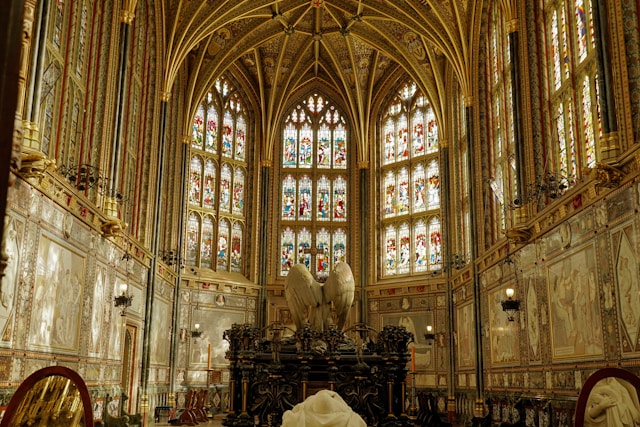Your cart is currently empty!
Discover the Historic and Architectural Gem: St. Andrews Church

A Place of Worship, History, and Architectural Splendor
Nestled amidst the vibrant streets of [city name], St. Andrews Church stands as a testament to the rich history and architectural heritage of the region. With its awe-inspiring medieval architecture, intricate stained-glass windows, and profound religious significance, this iconic landmark has captivated the hearts and minds of visitors for centuries.
Exploring the History of St. Andrews Church
The origins of St. Andrews Church can be traced back to the 12th century when a small Norman chapel occupied the site. Over the subsequent centuries, the church underwent several expansions and renovations, reflecting the changing needs of the congregation and the architectural styles prevalent at the time.
Norman Origins (12th Century)
The earliest incarnation of St. Andrews Church was a modest Norman chapel, built in the 12th century. This simple structure featured a nave and chancel, with thick stone walls and narrow, round-arched windows.
Gothic Expansion (13th-15th Centuries)
During the 13th and 15th centuries, the church underwent significant expansion in the Gothic style. The nave was extended, and the chancel was rebuilt with a larger and more elaborate east window. The addition of ribbed vaulting, pointed arches, and flying buttresses transformed the interior into a soaring and light-filled space.
Victorian Restoration (19th Century)
In the 19th century, the church underwent a major restoration under the leadership of architect George Gilbert Scott. Scott’s work included rebuilding the tower and spire, adding a new organ, and restoring the stained-glass windows. The Victorian restoration brought the church to its present-day appearance.
Architectural Highlights of St. Andrews Church
St. Andrews Church boasts an impressive array of architectural features that showcase the diversity of styles and techniques employed throughout its history.
Nave and Chancel
The nave, the main body of the church, is a vast and awe-inspiring space. The high ceilings, supported by ribbed vaulting, create a sense of grandeur. The chancel, located at the eastern end of the nave, is smaller and more intimate, featuring a large east window filled with vibrant stained glass.
Tower and Spire
The tower and spire of St. Andrews Church dominate the skyline of the city. The tower, built in the 15th century, is a square structure with a corbelled parapet. The spire, added in the 19th century, is an octagonal structure with a weathercock atop.
Stained-Glass Windows
St. Andrews Church is renowned for its magnificent stained-glass windows, which flood the interior with colorful light. The windows depict biblical scenes, historical figures, and intricate geometric patterns. Some of the most notable windows include the west window, which depicts the life of Christ, and the east window, which features a stunning representation of the Resurrection.
Religious Significance of St. Andrews Church
Beyond its architectural splendor, St. Andrews Church holds great religious significance for the local community and beyond.
Parish Church
St. Andrews Church serves as the parish church for the Anglican community of [city name]. It is a vibrant and active congregation that offers a range of services and activities throughout the week.
Pilgrimage Site
St. Andrews Church is believed to have been visited by St. Ninian, a 5th-century missionary who brought Christianity to Scotland. As a result, the church has become a pilgrimage site for Christians seeking to connect with their faith.
Community Hub
St. Andrews Church is more than just a place of worship. It is a vital community hub, hosting a variety of events and activities for people of all ages. These include concerts, exhibitions, and educational programs.
Tips for Visiting St. Andrews Church
* **Plan your visit during an open hour:** The church is typically open to visitors during specific hours, which may vary depending on the time of year. Check the church’s website for the most up-to-date information.
* **Attend a service:** Attending a service is a wonderful way to experience the spiritual and communal atmosphere of St. Andrews Church. Services are held regularly throughout the week.
* **Take a guided tour:** Guided tours are available by appointment and provide an in-depth look at the church’s history, architecture, and religious significance.
* **Explore the surroundings:** St. Andrews Church is surrounded by a beautiful churchyard and garden, perfect for a peaceful stroll or picnic.
* **Respect the sanctity of the church:** When visiting St. Andrews Church, be mindful of its religious significance and behave respectfully.
Conclusion
St. Andrews Church is a multifaceted masterpiece that embodies the rich history, architectural brilliance, and spiritual essence of [city name]. Its imposing architecture, stunning stained-glass windows, and profound religious significance make it a must-visit destination for anyone interested in history, architecture, or spirituality. Whether you are seeking a place of worship, a sanctuary for reflection, or simply an appreciation for the beauty of the past, St. Andrews Church is sure to leave a lasting impression on your heart and mind.